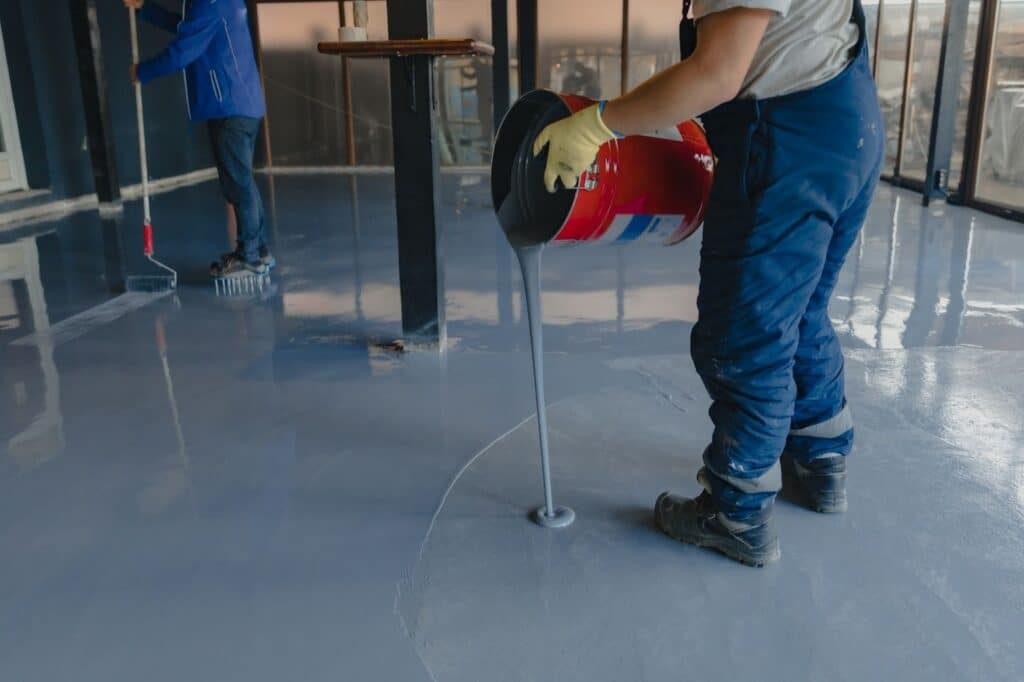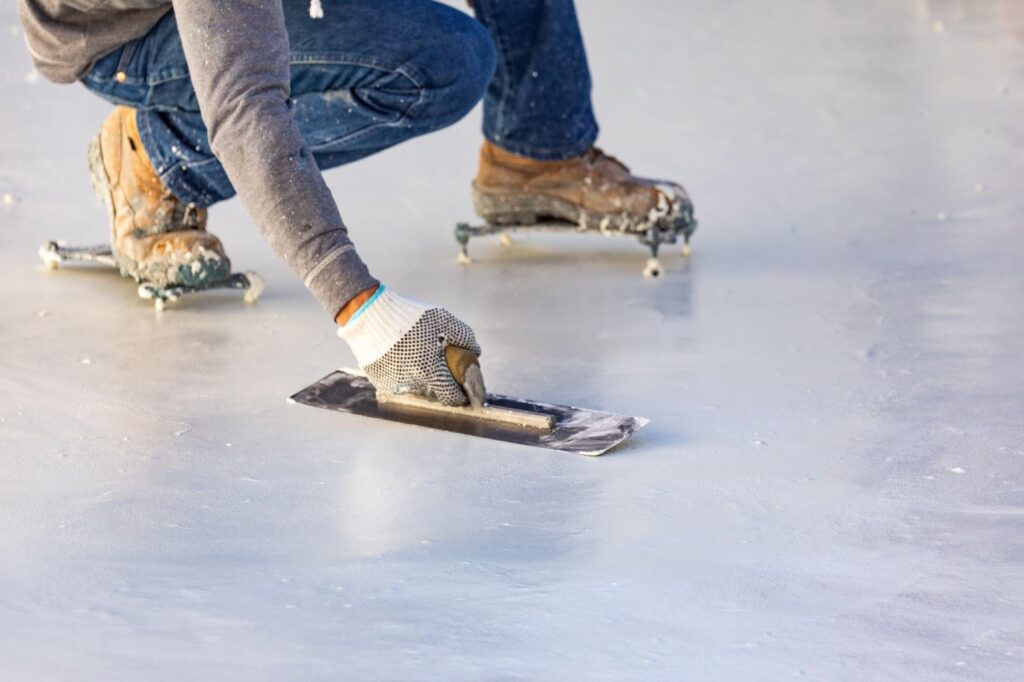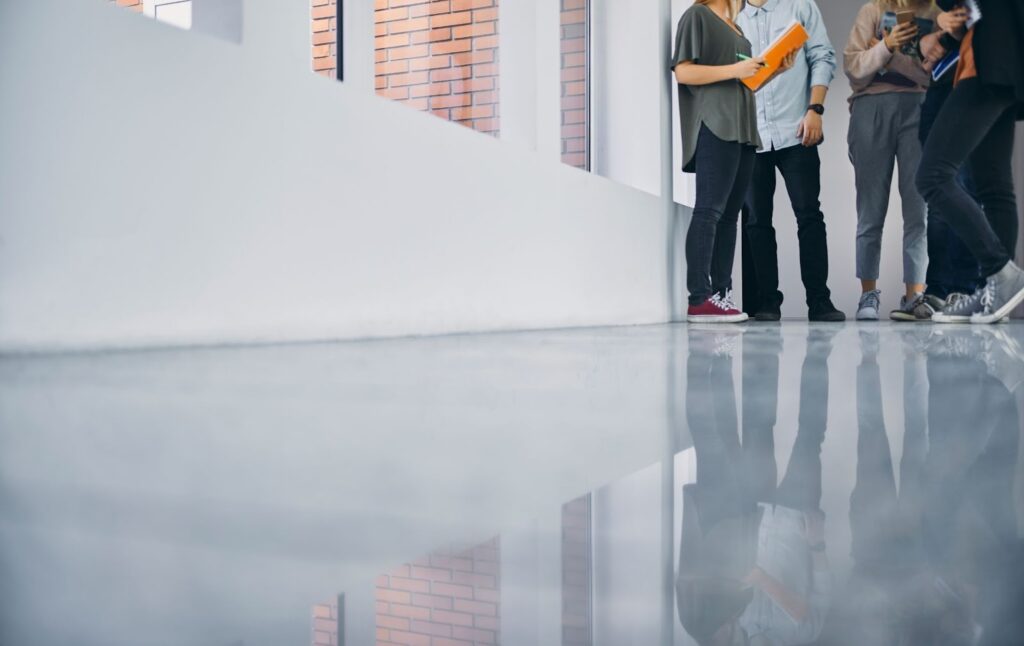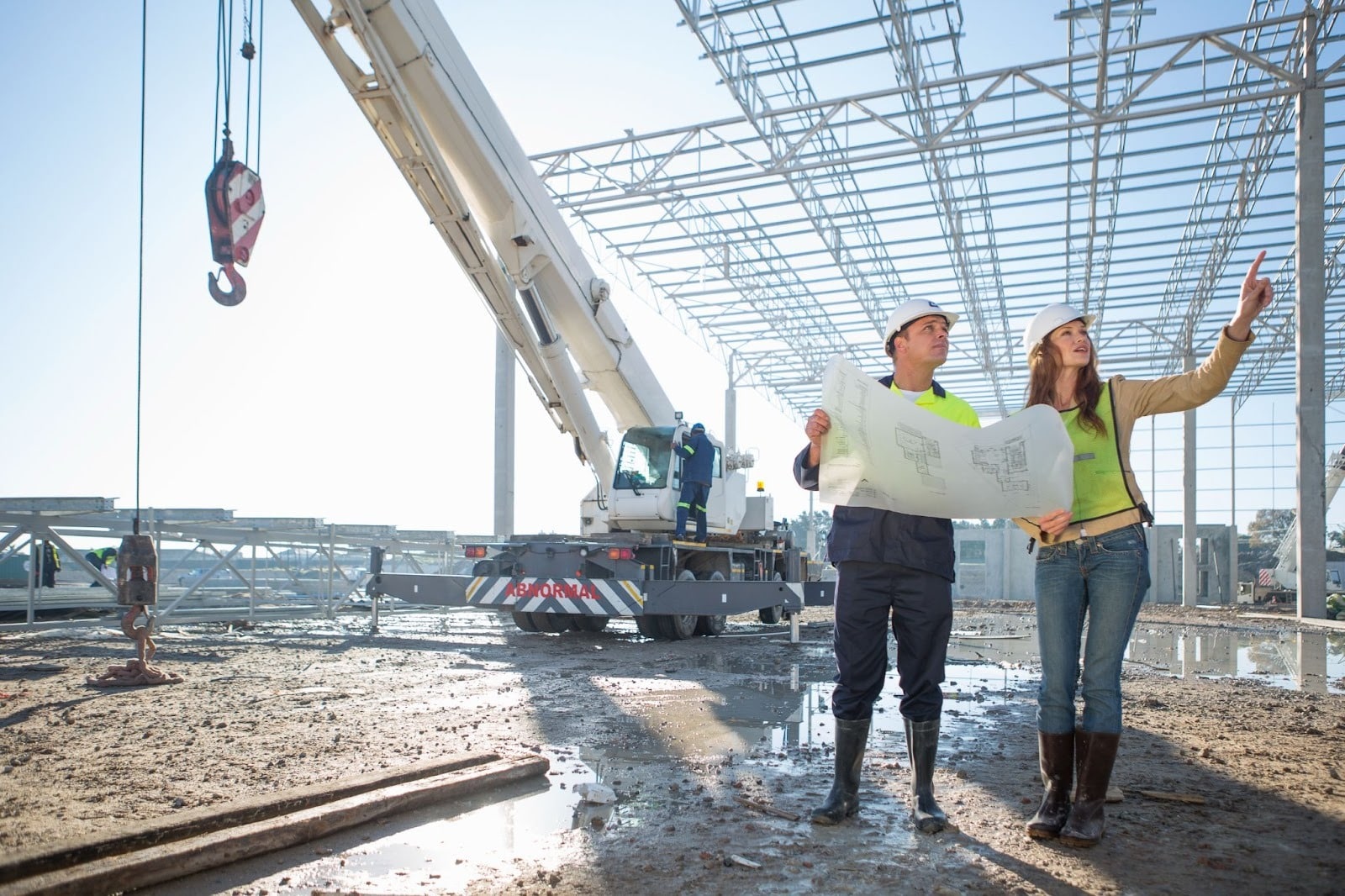Flooring choices can define how a space feels and functions for years. Homeowners and business owners want surfaces that look great, clean easily, and stand up to daily wear. Yet, choosing between epoxy flooring and traditional materials like wood, tile, or vinyl isn’t simple. Each brings unique qualities that affect comfort, cost, and longevity, shaping how people experience their homes or commercial spaces.
Understanding Epoxy Flooring Systems
Epoxy flooring is a seamless, durable coating that bonds tightly to concrete, creating a glossy and resilient surface. Made from resin and a hardener, it chemically forms a plastic-like finish. This process produces a non-porous, stain-resistant surface perfect for residential and commercial use. Its strength and modern appeal have made it a preferred choice in recent years.
What Epoxy Flooring is and How it Works
Epoxy flooring consists of several liquid layers that cure into a solid surface. When applied correctly, it seals concrete, preventing cracks and moisture intrusion. The surface resists oils, chemicals, and scratches better than most traditional floors. Due to its clean finish, it’s often found in garages, hospitals, warehouses, and luxury interiors. The smooth design also reduces allergens and dust, making it safer for families and staff.
Types of Epoxy Flooring and Their Uses
Different epoxy systems cater to distinct spaces and design goals. Self-leveling epoxy provides a sleek, polished surface for showrooms and offices. Flake epoxy adds textured color chips for traction in garages or gyms. Metallic epoxy creates swirling finishes that mimic marble, which is ideal for upscale interiors. Quartz epoxy mixes sand for durability and grip, perfect for kitchens or clinics. Each system can be customized for color, finish, and function.
Comparing Traditional Flooring Options
Traditional floors like hardwood, tile, and vinyl remain common for their familiar textures and aesthetic warmth. They appeal to homeowners who prefer classic designs and natural materials. However, their performance varies depending on maintenance habits and environmental conditions. Comparing them to epoxy reveals where practicality meets personal style.
Hardwood Flooring Features and Drawbacks
Hardwood flooring adds warmth and elegance to homes, but it needs consistent upkeep. When properly maintained, it can be sanded and refinished multiple times, extending its life. However, it scratches easily and warps under moisture, which limits its use in damp areas. The cost of installation and periodic refinishing makes it less economical over time. While hardwood has timeless charm, it demands more effort than modern epoxy systems.
Tile Flooring Durability and Care
Tile floors are known for their toughness and water resistance, making them ideal for kitchens and bathrooms: porcelain, ceramic, and natural stone offer diverse looks and textures. However, grout maintenance is tedious, and tiles can crack under impact. Replacing damaged pieces can be costly and disrupt uniformity. Compared with epoxy’s seamless surface, tile flooring feels more rigid and harder to maintain.
Vinyl and Laminate Flooring Benefits
Vinyl and laminate floors provide a low-cost way to imitate wood or stone textures. They are easy to install and require little cleaning. However, the thin surface layer can fade, peel, or scratch under heavy traffic. They’re not ideal for high-impact areas like garages or factories. While practical for short-term use, their lifespan and durability fall short compared to epoxy floors.
Concrete Flooring as a Base Layer
Concrete flooring delivers industrial charm and raw strength but lacks the finish and protection of epoxy. Unsealed concrete can crack, absorb stains, and generate dust over time. Applying epoxy on top transforms it into a resilient, easy-to-clean surface. The combination enhances durability and aesthetics, offering a strong foundation for decades. Many businesses choose this approach for its cost efficiency and visual upgrade.

Epoxy Flooring or Traditional Floors: Which Lasts Longer?
Flooring isn’t just about looks but about longevity, safety, and everyday practicality. The surface underfoot takes the most abuse, so choosing wisely determines how well your home or business stands the test of time. Between epoxy’s seamless strength and the character of traditional materials, the right option depends on how you live and work. Understanding their key differences reveals which surface truly delivers lasting value.
Durability and Maintenance Advantages
Durability directly affects flooring value, safety, and upkeep. A long-lasting surface reduces repair costs and prevents downtime in busy areas. Epoxy flooring’s structure offers superior protection from impact and moisture. Traditional floors, on the other hand, require ongoing attention to preserve their appearance.
Epoxy Flooring Resistance and Longevity
Epoxy flooring withstands heavy loads, spills, and chemicals without losing shine. It’s ideal for garages, industrial sites, and active households. Cleaning requires minimal effort since dirt doesn’t stick to the surface. When installed professionally, the finish resists chipping and peeling for years. Unlike wood or tile, epoxy maintains its condition without polishing or sealing, offering long-term stability that lowers ownership costs.
Traditional Floors and Maintenance Challenges
Traditional materials often need consistent care to retain their look. Hardwood demands sealing, polishing, or waxing every few years. Tile grout discolors over time, and vinyl fades under sunlight. These repetitive tasks add cost and inconvenience. While their charm is undeniable, traditional floors cannot match epoxy’s ease of upkeep and long-term durability, especially in high-traffic spaces.
Aesthetic and Design Adaptability
Floor design sets the tone of any space, influencing mood and visual flow. Both epoxy and traditional flooring offer aesthetic appeal, but in very different ways. Epoxy brings a modern, customizable finish that can resemble marble or granite. Traditional floors emphasize texture and organic patterns tied to classic design.
Epoxy Flooring Customization Options
Epoxy flooring allows unmatched creativity in design and color selection. Homeowners can choose metallic swirls, decorative flakes, or solid hues that match interior palettes. Commercial spaces often add branding or safety markings directly into the coating. The seamless surface reflects light, making rooms appear brighter and cleaner. With evolving design options, epoxy effortlessly fits both minimalist and contemporary spaces.
Traditional Flooring Visual Variety
Traditional flooring retains value for its tactile and natural appearance. Hardwood adds depth through natural grain patterns that no synthetic material can fully replicate. Stone tiles offer luxury with unique veining, though each piece varies in tone and texture. These variations give charm but can also complicate repairs. Epoxy provides a more controlled, consistent appearance while mimicking these textures if desired.

Cost and Installation Considerations
Flooring budgets depend on both initial cost and ongoing expenses. Traditional materials often appear cheaper upfront but require more maintenance over time. Epoxy flooring may cost more, but it saves money in repairs and cleaning. Installation quality and preparation strongly affect results, especially in large commercial projects.
Epoxy Flooring Installation Process
Installing epoxy requires proper surface preparation to remove dirt, cracks, or grease. Multiple coats are applied to build strength and gloss, each needing time to cure. Though it takes longer than laying vinyl or laminate, the outcome is far more durable—the coating bonds directly to concrete, reducing future repair needs. Over time, the investment pays off through lower upkeep and fewer replacements.
Cost Breakdown for Traditional Flooring
Traditional flooring costs vary widely by material and labor. Hardwood and tile installations require skilled craftsmanship, which raises expenses. Vinyl and laminate are faster to install but wear out sooner. Subfloor leveling and preparation add to the total cost, especially in older buildings. Comparing lifespan, epoxy’s longer performance justifies its higher initial price in homes and commercial properties.
Safety, Environment, and Performance
Modern flooring choices reflect health, sustainability, and practicality. Epoxy flooring excels in creating hygienic, low-maintenance environments. Its design minimizes hazards, supports sustainability, and improves overall safety. Traditional flooring, while familiar, varies in eco-friendliness and maintenance demands.
Safety Benefits of Epoxy Flooring
Epoxy flooring includes slip-resistant textures that enhance traction in wet areas. Its glossy finish improves light reflection, reducing the need for artificial lighting. Low-VOC options enhance indoor air quality and reduce environmental impact. Because the surface resists moisture, mold and bacteria growth are minimized. These qualities make it ideal for hospitals, schools, and family homes, prioritizing hygiene and safety.
Environmental Impact of Traditional Flooring
Traditional flooring materials impact sustainability in different ways. Hardwood, when responsibly sourced, is renewable but needs chemical finishes for protection. Vinyl and laminate involve plastics, contributing to waste and emissions: tile and stone mining strain natural resources. Epoxy’s longer lifespan reduces material turnover and disposal. The fewer replacements needed, the lower the long-term environmental footprint.
Residential and Commercial Suitability
Different properties demand flooring that balances beauty with performance. Epoxy flooring adapts to homes and businesses, offering durability and style flexibility. It performs well in high-traffic environments while staying visually appealing. Traditional materials, however, still win where heritage and natural feel are priorities.
Epoxy Flooring for Homes
Homeowners appreciate epoxy for its easy cleaning and smooth finish. It works well in basements, garages, kitchens, and even living rooms with modern interiors. The surface resists spills, pet claws, and foot traffic, maintaining shine for years. Its dust-free quality makes it suitable for allergy-sensitive families. The growing color and texture options make it a stylish alternative to tile or hardwood.
Epoxy Flooring for Businesses
Businesses prefer epoxy for its performance and professional appearance. Its strength withstands forklifts, carts, and heavy machinery in industrial settings. Showrooms use metallic finishes to impress customers, while hospitals rely on seamless designs for sanitation. Maintenance downtime is minimal, helping operations stay efficient. In competitive industries, epoxy offers a polished look that lasts through years of use.
When Traditional Flooring Still Matters
Traditional flooring retains emotional and cultural value that modern coatings cannot fully replace. Materials like hardwood and stone reflect craftsmanship, history, and authenticity that resonate with many homeowners. Their tactile warmth and natural imperfections bring life to heritage buildings and family spaces, creating a sense of comfort and identity. While epoxy flooring excels in durability and convenience, natural materials’ charm and resale appeal often outweigh their maintenance demands, making them timeless choices for those who appreciate tradition and lasting beauty.
Choose Epoxy Flooring for Lasting Strength and Style
The surface beneath your feet influences more than design—it defines how your space endures daily life. Epoxy flooring offers a reliable foundation that stays beautiful, functional, and easy to maintain for years. For homes and businesses aiming for modern appeal with long-term value, it’s the smarter investment. Now is the moment to invest in a surface that works as hard as you do.
Visit the JM Caulking & Construction Services LLC blog to learn how craftsmanship meets innovation in flooring.




